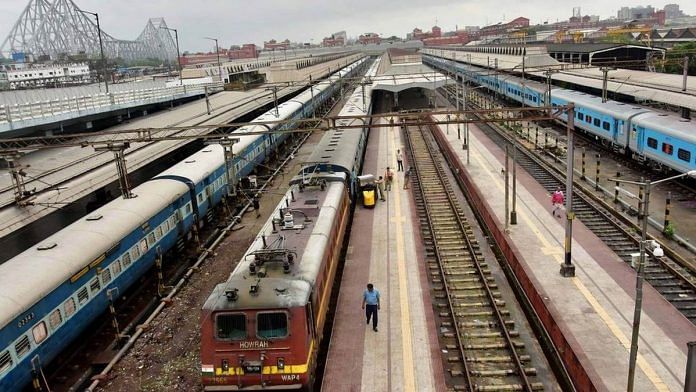New Delhi: Electronic sliding doors, windows with double-glazed safety glass, Braille signages, emergency talk-back mechanism, passenger surveillance system, and information and destination boards.
These are some of the specifications the Railways has demanded from private operators in trains that they will be running on the Railways network.
A draft specification for private trains, shared by the Railways on Wednesday, also says these trains would provide noise-free travel to passengers and be capable of running at a speed of 160 km/hr.
The train shall be designed so that they can operate safely at a maximum speed of 180 kmph during testing. Train shall be capable of accelerating to a speed of 160 kmph from 0 kmph in a maximum of 140 seconds on level track, says the draft.
These trains will be fitted with an emergency brake which can bring them to a standstill in less than 1,250 m when travelling at 160 kmph, it says.
It also says that the trains should be designed for a life of 35 years.
Each coach shall have minimum four electrically/pneumatically powered, plug type doors, two on each side, it says.
The door mechanism shall have safety provision whereby the train shall not start unless all doors have been closed and electrically locked.
Provision shall be made for passengers to open doors to permit evacuation from a stopped train in an emergency, the draft says.
There shall be an internal and external manual release mechanism on one door per side in each coach. All windows shall be provided with double-glazed safety glass, it says.
Stressing the need for hazard-free environment for users, the draft also says that adequate handholds shall be provided throughout the car.
The document also says normal and emergency equipment and controls which the users or crew may operate shall be clearly identified, and operating procedures presented in both text and graphic formats.
Passenger emergency signs shall also be embossed in Braille raised typeface, it says.
The trains shall be designed to keep the noise emissions as low as possible and designed to prevent drumming, rattles or vibrations throughout its life.
The draft says the train shall provide a public address (PA) facility so that the loco pilot or guard can make announcements to passengers from driving /non-driving cab.
Emergency buttons and talk-back phones shall be located near all the doors and gangways, the draft says, adding provision shall be there for voice recording of the conversations with GPS stamping.
A passenger information system (PIS) shall provide automatic announcement and the display of destination information on displays throughout the train in Hindi, English and regional languages.
Each car shall be provided with two digital destination boards on the outside (one on each side) displaying the originating, destination station, vehicle number, train number, the draft says.
The passenger coach surveillance system (PRSS) shall comprise an IP-based close circuit television (CCTV) network, surveillance cameras and other accessories as required with onboard equipment for streaming of video to the central server for selected cameras, it says.
Each sitting car of train shall be provided with minimum six surveillance cameras to cover the passenger area. For a sleeper train, each car shall be provided with two surveillance cameras at appropriate location to cover the entire corridor, the draft says.
In addition, adequate numbers in the gangway/vestibule area as deemed necessary shall also be provided.
Additionally, at least one camera shall be placed in Driving Cab for gathering frontend view, track and OHE conditions etc. Cameras shall be placed on outer side of the train for gathering rear view of the platform. One/two camera shall be installed on the roof of driving Car/power head towards pantograph to monitor the roof equipment, it said.
An integrated screen shall be provided for the passenger car surveillance system in each driving cab.
The train will also have an Emergency Talk-Back [ETB] (on two physically independent channels) in each coach.
Once pressed/operated, it shall be possible for the passenger to communicate with the train driver/guard. If more than one emergency device has been operated, each demand shall be independently acknowledged, it said. –PTI
Also read: For these top Railways bosses, the train of jobs doesn’t stop even after retirement



